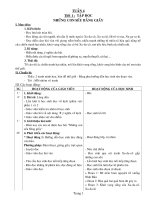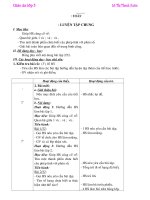Efficient logistics a key to vietnams competitiveness
Bạn đang xem bản rút gọn của tài liệu. Xem và tải ngay bản đầy đủ của tài liệu tại đây (5.72 MB, 203 trang )
Efficient Logistics
Blancas, Isbell, Isbell, Tan, Tao
THE WORLD BANK
Efficient Logistics
A Key to Vietnam’s Competitiveness
Luis C. Blancas, John Isbell, Monica Isbell, Hua Joo Tan, Wendy Tao
DIRECTIONS IN DEVELOPMENT
Countries and Regions
Public Disclosure AuthorizedPublic Disclosure AuthorizedPublic Disclosure AuthorizedPublic Disclosure Authorized
83031
Efficient Logistics
DIRECTIONS IN DEVELOPMENT
Countries and Regions
Efficient Logistics
A Key to Vietnam’s Competitiveness
Luis C. Blancas, John Isbell, Monica Isbell, Hua Joo Tan, Wendy Tao
Efficient Logistics • />© 2014 International Bank for Reconstruction and Development / The World Bank
1818 H Street NW, Washington DC 20433
Telephone: 202-473-1000; Internet: www.worldbank.org
Some rights reserved
1 2 3 4 16 15 14 13
This work is a product of the staff of The World Bank with external contributions. Note that The World
Bank does not necessarily own each component of the content included in the work. The World Bank
therefore does not warrant that the use of the content contained in the work will not infringe on the rights
of third parties. The risk of claims resulting from such infringement rests solely with you.
The findings, interpretations, and conclusions expressed in this work do not necessarily reflect the views
of The World Bank, its Board of Executive Directors, or the governments they represent. The World Bank
does not guarantee the accuracy of the data included in this work. The boundaries, colors, denominations,
and other information shown on any map in this work do not imply any judgment on the part of The World
Bank concerning the legal status of any territory or the endorsement or acceptance of such boundaries.
Nothing herein shall constitute or be considered to be a limitation upon or waiver of the privileges and
immunities of The World Bank, all of which are specifically reserved.
Rights and Permissions
This work is available under the Creative Commons Attribution 3.0 Unported license (CC BY 3.0) http://
creativecommons.org/licenses/by/3.0. Under the Creative Commons Attribution license, you are free to
copy, distribute, transmit, and adapt this work, including for commercial purposes, under the following
conditions:
Attribution—Please cite the work as follows: Blancas, Luis C., John Isbell, Monica Isbell, Hua Joo Tan, and
Wendy Tao. 2014. Efficient Logistics: A Key to Vietnam’s Competitiveness. Directions in Development.
Washington, DC: World Bank. doi:10.1596/978-1-4648-0103-7. License: Creative Commons
Attribution CC BY 3.0
Translations—If you create a translation of this work, please add the following disclaimer along with the
attribution: This translation was not created by The World Bank and should not be considered an official
World Bank translation. The World Bank shall not be liable for any content or error in this translation.
All queries on rights and licenses should be addressed to the Office of the Publisher, The World Bank, 1818
H Street NW, Washington, DC 20433, USA; fax: 202-522-2625; e-mail:
ISBN (paper): 978-1-4648-0103-7
ISBN (electronic): 978-1-4648-0104-4
DOI: 10.1596/978-1-4648-0103-7
Cover photo: © Joesboy / Getty Images. Used with permission of Joesboy / Getty Images. Further permission
required for reuse.
Cover design: Debra Naylor
Library of Congress Cataloging-in-Publication Data
Blancas, Luis C. Efficient logistics : a key to Vietnam’s competitiveness / Luis C. Blancas, John Isbell, Monica
Isbell, Hua Joo Tan, Wendy Ta.
1 online resource. — (Directions in development)
Includes bibliographical references. Description based on print version record and CIP data provided by
publisher; resource not viewed.
ISBN 978-1-4648-0104-4 (epub) — ISBN 978-1-4648-0103-7 (alk. paper)
1. Freight and freightage—Vietnam. 2. Business logistics—Vietnam. 3. Industrial policy—Vietnam.
4. Economic development—Vietnam. 5. Vietnam—Economic policy. I. World Bank. II. Title.
HE199.V5
388’.04409597—dc23 2013041631
Efficient Logistics •
v
Foreword xi
Acknowledgements xiii
About the Authors xv
Abbreviations xvii
Overview 1
Chapter 1 Introduction 7
Objective and Scope 7
Approach and Methodology 8
Note 10
Chapter 2 Vietnam’s Current Situation 11
Economic Overview 11
Status of Existing Infrastructure 23
Strategic Freight Corridors 49
Notes 63
References 65
Chapter 3 Freight Stakeholder Challenges and Opportunities 69
Marine Terminal Operators 69
Ocean Carriers 74
Logistics Service Providers 80
International BCOs 91
Domestic BCOs 108
Trucking Industry 110
Notes 111
Reference 112
Chapter 4 Issues Screening and List of Actionable Recommendations 113
Freight Logistics Challenges 113
Development of a Multicriteria Evaluation Matrix 119
Contents
vi Contents
Efficient Logistics • />Goals Assessment and Recommendations to
Improve Performance 120
Institutional Mechanisms to Support Logistics Policy
Making 143
Notes 144
References 145
Appendix A Supporting Calculations 147
Appendix B Overweight Container Audit Process 159
Miniature Concept of Operations for Automated Weight
Auditing and Fine Assessment 159
Note 160
Appendix C Entities Interviewed 161
International and Domestic Beneficial Cargo Owners: 27 161
Factories: 4 161
Logistics Service Providers: 11 161
Ocean Carriers: 5 161
Marine Terminal Operators: 15 162
Trucking Companies: 4 162
Trade Associations: 4 162
Government Entities: 4 162
Appendix D Methodology for Calculating the Cost of Congestion
on the Vietnamese Economy 163
References 166
Appendix E Customs Flow Charts 167
Appendix F Components of Successful Public-Private Partnerships 171
Reference 173
Appendix G Organizational Structure of the Ministry of Transport
of Vietnam 175
Glossary 179
Boxes
3.1 CenterPoint Intermodal Center, Ellwood, Illinois 87
4.1 Ports of Los Angeles and Long Beach Clean Truck Program 136
4.2 Global Logistic Properties Road Ports: China Test 138
F.1 Florida State Department of Transportation PPP for I-595 172
F.2 Structuring Successful Public Private Partnerships 172
Contents vii
Efficient Logistics •
Figures
1.1 Analytical Approach 9
2.1 Vietnam GDP by Industry Sector, 1990–2011 12
2.2 Regional Origin of Vietnam’s Six Key Export Commodities 13
2.3 Average Worker Monthly Base Salary in Select Cities of
Developing Asian Countries, 2011 15
2.4 Structure of Government Institutions in the Transport Sector 20
2.5 Vietnam: Container Handling Volume by Region, 2000–11 25
2.6 Estimated Terminal Utilization Levels at HCMC and
Cai Mep-Thi Vai Ports 30
2.7 Vietnam: Demand and Supply at Southern Region
Ports, 2000–20 31
2.8 Number of Weekly Linehaul Services Calling at
Cai Mep-Thi Vai, 2009–12 31
2.9 Vietnam: Demand-Supply at Northern Ports without Lach Huyen 34
2.10 Comparison of Ocean Freight Rates to Japan and the
United States, 2006–11 35
2.11 Haiphong/Cai Lan Port Utilization Rates by Terminal, 2010–20 36
2.12 Vietnam: Demand and Supply at Northern Region
Ports, 2000–20 37
2.13 Average Container Vessel Sizes Calling Haiphong and Cai Lan,
September 2012 37
3.1 Asia-North Europe Services: Average Vessel Size, October 2012 71
3.2 Ocean Carriers: Relative Cost of Operations in Vietnam 75
3.3 Challenges That Impact Ocean Carrier Operation Costs
in Vietnam 76
3.4 Qualities of the Ocean Carrier Staff Functions for the Industry 76
3.5 Perceived Port Operations Performance 77
3.6 Comparison of Vietnam Operating Costs to
Other Asian Countries 81
3.7 Vietnam Trucking Costs Compared with Other Asian Countries 83
3.8 Vietnam Trucking Service Quality Compared with Other Asian
Countries 84
3.9 Average Rating of the Perceived Business Impacts of Inland
Trucking Factors 88
3.10 Type of Products Exported by Respondents 91
3.11 Types of Products Imported by Respondents 92
3.12 Marine Terminals Used by Respondents 93
3.13 Trucking Costs in Vietnam Compared with Other
Asian Countries 95
3.14 Trucking Service Quality in Vietnam Compared with Other
Asian Countries 95
3.15 Perceived Level of Highway Congestion in Vietnam Relative to
Regional Peers 97
3.16 Factors Impacting Airfreight Logistics Costs 100
viii Contents
Efficient Logistics • />3.17 Adequacy of Warehouse Facilities 101
3.18 Comparison of Warehousing in Vietnam with That of Other
Asian Countries 102
E.1 Import Customs Clearance: e-Declaration Process Flow 168
E.2 Export Customs Clearance Process 169
G.1 MoT Organization: 2012 176
Maps
2.1 Vietnam: Economic Geography 16
2.2 Vietnam: Six Port Groups and Main Container Ports (above
10,000 TEUs per annum) 27
2.3 Vietnam: Greater HCMC Main Container Terminals 42
2.4 Vietnam: Fragmentation of the Haiphong Port System 44
2.5 Location of Van Phong in Vietnam’s Main-Port Network 46
2.6 Vietnam: Six Primary Freight Corridors 51
2.7 HCMC-Long Thanh-Dau Giay Expressway 54
2.8 HCMC-Long Thanh-Dau Giay Expressway Link to Can Tho 55
2.9 Cho Gao Canal 60
2.10 Vietnam National Railway System 62
B3.1.1 CenterPoint Intermodal Center, Ellwood, Illinois 87
Tables
2.1 Vietnam Average Annual GDP Growth by Sector 12
2.2 Vietnam’s Top 12 Trading Partners, 2011 14
2.3 Vietnam’s Freight Volumes by Mode, 2008 and Forecast
to 2030 19
2.4 Import Cost Comparisons for 40-Foot Container of General
Merchandise 21
2.5 Export Landed Cost Comparisons for 40-Foot Container of
General Merchandise 21
2.6 Vietnam: Container Ports, Handling Volumes, 2007–11 24
2.7 Vietnam: Current Terminals at Ho Chi Minh City and
Cai Mep-Thi Vai 29
2.8 Vietnam: New Terminals Planned at Ho Chi Minh City and
Cai Mep-Thi Vai 30
2.9 Linehaul Services Calling at Cai Mep-Thi Vai as of
September 2012 32
2.10 Current and Expected Terminals in Northern Vietnam:
Haiphong, Dinh Vu, Cai Lan, and Lach Huyen 33
2.11 Vinalines’ Shareholdings of Main Vietnamese Ports and
Planned Projects 41
2.12 Vietnam: Top 30 Global Container Ports in 2011 and
Fragmentation of Vietnamese Ports 45
2.13 Distance from Main Southeast Asia Gateway Ports to Van Phong 47
Contents ix
Efficient Logistics •
2.14 Truck Cost Savings from Decreasing Congestion in the
HCMC Area 52
2.15 Estimates for Costs of Truck-Related Congestion in Vietnamese
Cities and Regions (2010 Data) 53
2.16 Estimates for Total Costs of Congestion (by All Vehicles) in
Vietnamese Cities and Regions (2010 Data) 53
2.17 Cai Mep-Thi Vai Terminals, Daily Truck Trips 56
2.18 Road and Coastal Containerized Cargo Flows on Vietnam’s
North-South Trade Axis 61
3.1 Largest Container Vessels at Cai Mep-Thi Vai Terminals
since 2009 70
3.2 Domestic Carriers Serving the Haiphong-Quinhon-
Danang-HCMC Coastal Trades, September 2012 72
3.3 Comparison of Transshipment Costs at Cai Mep Relative to
Key Regional Hubs 73
3.4 Containerized Ocean Carriers Calling Vietnam 74
3.5 Positive and Negative Aspects of ICDs 77
3.6 Trucking Industry: Perceptions of Ocean Carriers 78
3.7 LSPs’ Opinions about Vietnam Customs Processes 81
3.8 LSPs’ Opinions about Vietnam’s Trucking Industry 84
3.9 Respondents’ Opinions about Vietnam’s Logistics Parks 85
3.10 Quality of Tan Son Nhat Airport 88
3.11 Quality of Noi Bai Airport 88
3.12 Total 2011 Annual Export Volumes Reported by Respondents 92
3.13 Total 2011 Annual Import Volumes Reported by Respondents 92
3.14 Trucking Industry Conditions 96
3.15 Quality of Tan Son Nhat Airport 99
3.16 Quality of Noi Bai Airport 100
3.17 Characteristics of Customs and the Import/Export Process 103
4.1 Most Significant Challenges Impacting Freight Logistics Costs
in Vietnam 114
4.2 Multicriteria Evaluation Impact Variables 120
4.3 Scoring System 120
4.4 Significant Challenges: Weighted Average Scores 121
4.5 Key Goals and Impact on Freight Stakeholders 122
4.6 Interest Cost on Extra Inventory Due to Import-Export
Clearance Delays 126
4.7 Import and Export Origin Costs for General Merchandise
Cargo in 40-Foot Container (FEU) 127
4.8 Estimated Cost of Facilitation Payments in Clearing and
Transporting Import and Export Containers 128
4.9 Highway Congestion Cost Impact on Trucking Costs 131
4.10 Cost of a Notional Truck Replacement Program 139
4.11 Terminal Handling Charges for Vietnam and Neighboring
Countries, 2012 142
x Contents
Efficient Logistics • />A.1 Forecast Import and Export Container Volumes 148
A.2 Vietnam, China, and Indonesia Landed Cost Comparisons 150
A.3 Inventory Carrying Costs from Import-Export Clearance Delays 152
A.4 Trucking Cost of Congestion 153
A.5 Estimation of Facilitation Costs 155
A.6 Cost to Finance New Clean Diesel Trucks 157
D.1 Estimates for Costs of Congestion in Various Sample Cities 164
D.2 Estimates for Truck Delay Costs of Congestion in Vietnamese
Cities and Regions, 2010 165
D.3 Estimates for Total Costs of Congestion in Vietnamese Cities
and Regions, 2010 165
Efficient Logistics •
xi
Foreword
The old economic structure is no longer relevant: Vietnam needs to improve its competitive-
ness, facilitate stronger levels of creativity in economic production, and recognize that in a
Vietnamese economy that is increasingly open and integrated to the global economy the
low-hanging fruits have nearly been harvested.
—H.E. Bùi Quang Vinh, Minister of Planning and Investment, Socialist Republic of
Vietnam, July 15, 2013
Over the past 20 years Vietnam has achieved sustained economic growth primar-
ily driven by a rapidly expanding labor force and a shift in economic activity away
from low-productivity subsistence agriculture toward the higher- productivity
manufacturing and services sectors. Crucially, supported by pro-poor social poli-
cies, strong growth was accompanied by remarkable poverty reduction outcomes.
Vietnam’s continued macroeconomic stability, increasing economic liberaliza-
tion, and young, vast labor pool have increased the country’s attractiveness as a
destination for foreign direct investment—particularly as labor costs have
increased in key competing markets, most notably China.
Vietnam’s socioeconomic success story, however, now faces both short- and
long-term challenges. Since the onset of the global economic crisis of 2008–2009,
the Vietnamese economy has undergone a particularly challenging period of
declining foreign capital inflows and subdued, as well as more contested, export
markets. Recent reductions in economic growth, seen for the first time since the
Asian economic crisis of 1999, highlight the importance of strengthening eco-
nomic resiliency.
Over the longer term, Vietnam is faced with the challenge that both its main
drivers of past growth—labor force growth and intersectoral shifts in economic
activity—are being depleted and need to be replaced by intrasectoral productiv-
ity improvements.
More efficient transport and logistics can play a significant role in increasing
productivity going forward. By making supply chains more predictable, better
transport and logistics allow manufacturers, transportation carriers, logistics ser-
vice providers, and trade regulators to minimize avoidable delays, thereby
increasing output per unit of time while reducing the cost of doing business.
Such competitiveness enhancements can better position Vietnam to benefit
xii Foreword
Efficient Logistics • />from global demand, to better serve domestic markets, to attract investment, and
to generate quality jobs.
This report makes the case that improvements in export, import, and domes-
tic logistics operations as a driver of future growth for Vietnam are fully within
grasp. The report highlights opportunities to make freight itineraries more reli-
able, to make roads safer and more conducive to high-volume commercial use,
to increase port sector efficiencies, and to better integrate barges, trucks, ware-
houses, and gateways. It also proposes interventions and policies that can address
these challenges over the short term and following years.
I hope this report will contribute to a dialogue that can bring together public
and private sector stakeholders, including the World Bank, as we continue to
explore and support ways to make Vietnam’s economy more competitive and
dynamic going forward.
John A. Roome
Director
Sustainable Development
East Asia and the Pacific
World Bank
Efficient Logistics •
xiii
Acknowledgements
This diagnostic report was prepared by the East Asia and Pacific Region of the
World Bank. The work was led by Luis C. Blancas (Transport Specialist, EASIN),
under the overall guidance of John Roome (Sector Director, EASSD), Victoria
Kwakwa (Country Director, EACVF), Jennifer Sara (Sector Manager, EASVS),
Abhas Jha (Sector Manager, EASIN), and Paul Vallely (Senior Transport Specialist
and Transport Cluster Leader, EASVS). The report’s co-authors are Luis C.
Blancas of the World Bank; John Isbell, Monica Isbell, and Wendy Tao of
Cambridge Systematics, Inc.; and Hua Joo Tan, Consultant.
The team is grateful for detailed comments provided by World Bank peer
reviewers Arturo Ardila Gomez (Senior Urban Transport Specialist, LCSTR),
James Anderson (Senior Governance Specialist, EASPV), Monica Alina Mustra
(Trade Specialist, PRMTR), Jordan Schwartz (Manager, TWISI), Deepak Mishra
(Lead Economist, EASPR), and Myla Taylor Williams (Country Program
Coordinator, EACVQ). Comments on earlier drafts were received from M.
Baher El-Hifnawi (Lead Transport Economist, ECSTR), Simon David Ellis
(Senior Transport Economist, SASDT), Duc Minh Pham (Senior Economist,
EASPV), Reynaldo Bench (Senior Port Specialist, TWITR), Dung Anh Hoang
(Senior Transport Specialist, EASVS), and Christopher De Serio (Operations
Analyst, EASIN). Thao Phuong Tuong (Team Assistant, EACVF), Carla Teresa
Sarmiento (Resource Management Assistant, EAPCA), Iris David (Program
Assistant, EASIN), Teresita Ortega (Program Assistant, EASWE), and Cristina
Hernandez (Program Assistant, EASWE) provided excellent production support
throughout.
The information and insight obtained from numerous private companies,
transport carriers, logistics service providers, trade groups, and government offi-
cials in Vietnam and elsewhere are gratefully recognized.
Finally, the team acknowledges the generous support from the Australian
Agency for International Development (AusAID) provided through the World
Bank East Asia and Pacific Infrastructure for Growth Trust Fund (EAAIG).
Efficient Logistics •
xv
Luis C. Blancas is a Transport Specialist with the Sustainable Development
Department in the East Asia and the Pacific region of the World Bank. Since
2010 he has led and participated in the preparation and supervision of several
World Bank-financed transport infrastructure projects in Vietnam, including
interventions to expand capacity and increase efficiency in the country’s Red
River Delta and Mekong River Delta inland waterway networks and projects to
develop Vietnam’s expressway sector. He has also conducted public sector tech-
nical assistance and analytical work in transport and logistics in China, Malaysia,
and Vietnam. Prior to joining the World Bank he was an Associate with
MergeGlobal, a financial and strategic advisor to firms in the global transport and
logistics industry; a Research Analyst at the Fiscal Affairs Department of the
International Monetary Fund; and a management consultant with Deloitte
Consulting’s Mexico and Central America practice. Mr. Blancas holds a Master’s
degree in Management Science and Engineering from Stanford University and a
B.A. in Economics from Mexico’s Monterrey Institute of Technology.
John Isbell is a Freight and Logistics Specialist with Cambridge Systematics, Inc.
He has more than 34 years of experience in the areas of global supply chain
management, performance-based contracts, and value creation in transportation
service provision and management. Prior to becoming a consultant to public and
private sector entities in the broad areas of transport and logistics he was Director
of Corporate Delivery Logistics for Nike, Inc. During the last 10 of his 31 years
with Nike, he directed the activities of the Corporate Delivery Logistics group,
which was responsible for the strategic direction and global management of
Nike’s logistics service providers delivering origin consolidation, ocean freight,
and air freight of both in-line and product samples, supply chain security, and
claims management. Mr. Isbell holds an M.B.A. from Portland State University.
Monica Isbell is Practice Leader for Supply Chain and Logistics at Cambridge
Systematics, Inc. She has more than 32 years of experience as an international
logistician, focused on helping private sector companies streamline their supply
chains and optimize their processes. She also has helped ports, departments of
transportation, metropolitan planning organizations, and others to develop strat-
egies to better meet the needs of shippers and logistics service providers. Prior to
About the Authors
xvi About the Authors
Efficient Logistics • />joining Cambridge Systematics, she was founder and President of Starboard
Alliance Company LLC, an international trade, transportation, and supply chain
consulting practice. Ms. Isbell also has held executive positions with Columbia
Sportswear Company, Asics Tiger Corp, Direct Line Cargo Management
Services/DHL Global Forwarding, and Sea-Land Service. Ms. Isbell holds a B.A.
from Princeton University.
Hua Joo Tan is an Independent Maritime Consultant with more than 15 years of
experience. As a Managing Director of American President Lines (APL) Vietnam,
he managed the ocean shipping and supply chain management services of APL
and APL Logistics with more than 150 staff in four locations across Vietnam. He
also served as member of the Board of Directors of the second largest container
port in Vietnam and as chairman of a container shipping company operating in
the Vietnam-Singapore feeder trade. He led the Ports Subgroup of the
Infrastructure Working Group of the Vietnam Business Forum. As leader of the
ports group, Mr. Tan led the efforts to spearhead the industry’s concerns on ports
and related infrastructure issues in Vietnam, including the preparation of posi-
tion papers and conduction of discussions with government ministries, including
the biannual Forum discussions and the introduction of Terminal Handling
Charges at Vietnamese ports. Mr. Tan holds an M.B.A. from Stanford University
and a B.A. in Economics from the University of Oxford.
Wendy Tao is an Associate Consultant with Cambridge Systematics, Inc. She has
eight years of experience in transport economics and has assisted the Southern
California Association of Governments (SCAG) in assessing the supply adequacy
of industrial/warehouse and intermodal facilities relative to future growth. Prior
to joining Cambridge Systematics, Ms. Tao was the Hanoi coordinator of the
Partnership for Sustainable Urban Transport in Asia, for which she collected and
evaluated greenhouse gas data along with information to evaluate air quality,
traffic, and safety for the Hanoi government. As part of a U.S. Strategic Highway
Research Program project focused on the interactions between transportation
capacity, economic systems, and land use, Ms. Tao conducted a targeted case
study on Global III Intermodal Terminal in Rochelle, Illinois, as well as highway
facilities in California, including the Sonora bypasses, SR 99, and Hollister SR
156. Ms. Tao holds an M.S. in Transportation Engineering and City Planning from
the University of California, Berkeley, and a B.S. in Economics and Environmental
Policy from the University of Pennsylvania Wharton School.
Efficient Logistics •
xvii
AEC ASEAN Economic Community
AMS Automated Manifest Service
ASEAN Association of Southeast Asian Nations
BCO beneficial cargo owner
BOT Build-Operate-Transfer
CFS Container Freight Station
CIC Container Imbalance Charge
CICT Cai Lan International Container Terminal
CMICT Cai Mep–Thi Vai International Terminal
CMIT Cai Mep International Terminal
CM-TV Cai Mep–Thi Vai
C-TPAT Customs-Trade Partnership Against Terrorism
CY container yard
DWT deadweight tons
EDI electronic data interchange
EU European Union
FDI foreign direct investment
FEU 40-foot equivalent unit container
FTP File Transfer Protocol
GoV Government of Vietnam
GPS Global Positioning System
GDP gross domestic product
HCMC Ho Chi Minh City
ICD inland container depot
ISF International Security Filing
IT information technology
IWT Inland Waterway Transport
JETRO Japan External Trade Organization
JIT just-in-time
Abbreviations
xviii Abbreviations
Efficient Logistics • />LNG liquid natural gas
LO/LO lift on/lift off
LPI Logistics Performance Index
LPR License Plate Reader
LSP logistics service provider
MCIP Multimodal Corridor Investment Plan
MoT Ministry of Transport of Vietnam
MTO marine terminal operator
NBA Noi Bai Airport
NH National Highway
OECD Organization for Economic Co-operation and Development
PPP public-private partnership
SAR special administrative region
SCSC Saigon Cargo Service Corporation
SITC Standard International Trade Classification
SITV Saigon International Terminals Vietnam
SOE state-owned enterprise
SNP Saigon New Port
SP Saigon Port
SPCT Saigon Premier Container Terminal
SP-PSA Saigon Port–Port of Singapore Authority International Port
SSIT SP–SSA International Terminal
STS ship-to-shore
TCCT Tan Cang–Cai Mep Container Terminal
TCIT Tan Cang–Cai Mep International Terminal
TCS Tan Son Nhat Cargo Services
TEU 20-foot equivalent unit container
THC terminal handling charge
TPP Trans-Pacific Partnership
TSNA Tan Son Nhat Airport
VCIS Vietnam Customs Information System
VICT Vietnam International Container Terminals
VNACCS Vietnam Automated Cargo and Port Consolidated System
VND Vietnamese dong
VOC vehicle operating costs
VPA Vietnam Port Association
WTO World Trade Organization
1
Efficient Logistics •
Overview
The Government of Vietnam (GoV) has articulated the goal for Vietnam to
become an industrialized country by 2020. Vietnam has attained sustained
economic growth and widespread poverty reduction over the past 20 years. This
impressive growth performance—largely based on the promotion of exports and
investment—placed Vietnam among the world’s five fastest-growing economies
of the 1990–2010 period and has benefited, particularly over the past 10 years,
from attractive labor cost rates relative to key Asian peers, like China. Yet as labor
supply growth decelerates over the next couple of decades, achieving the
country’s vision to 2020 and beyond will require a much greater focus on
productivity improvements as a source of growth. In this respect, competitive-
ness, and in particular higher transport and logistics efficiency, is increasingly
becoming a critical growth sustainability driver for Vietnam.
The performance of Vietnam’s trade logistics system (defined as infrastruc-
ture provision, facilities and equipment, service delivery, and the institutional
and regulatory environment supporting logistics operations), while stronger
than that of some regional peers, trails some of the more globally integrated
developing Asian nations. As a rapidly growing economy in transition (e.g., it has
recently joined the ranks of middle income countries), Vietnam has provided
basic infrastructure access to an industrial and manufacturing base that is
increasingly interconnected with the rest of the world. This, coupled with a his-
tory of social and political stability following the economic reforms of the late
1980s and a favorable geographic position relative to the world’s busiest
maritime trade lanes and container hubs, has facilitated a strong trade sector
performance over the past 20 years. Yet improving logistics efficiency remains
a development challenge. While no single, definitive measure of logistics
performance exists, several indicators suggest that Vietnam’s logistics (along
such dimensions as inventory carrying costs in supply chains, the incidence of
transport and handling delays, the availability of talent in logistics management,
and the processing of permits and clearances in international trade) underper-
forms that of China, Malaysia, and Thailand among developing countries in
Asia. Because Vietnam’s logistics costs are perceived to be high relative to these
2 Overview
Efficient Logistics • />key peers, reducing logistics costs can be a major component of the broader
GoV agenda towards solidifying the country’s long-term economic develop-
ment trajectory.
The purpose of this report is to identify the most pressing challenges driving
transportation and logistics costs in Vietnam and to recommend policies and
interventions that could strengthen competitiveness. The methodology used in
the report was multifaceted. Numerous freight stakeholders, trade associations,
and government ministries were interviewed face to face in August 2012 through
tailored questionnaires. The study assessed the existing conditions of key ports,
highways, and airports with site visits and first-hand observations. The analysis
also benefited from a thorough review of the literature, including past World Bank
studies, to better integrate this available body of knowledge into a cohesive ana-
lytical framework.
The report finds that, to the extent that logistics operations in Vietnam are
costlier than similar operations in other countries in the region, this is due to a
persistent lack of reliability throughout the supply chain. When logistics costs
are broken down by their component parts, it is apparent that Vietnam’s relative
logistics underperformance does not originate from the transport costs side of the
equation—particularly given the present overcapacity in many transport sectors,
which tends to drive down transportation rates—but primarily from the ware-
housing and inventory carrying costs side of the equation. The latter are directly
dependent on supply chain reliability and predictability. As Vietnam seeks to
compete in the world economy and trade in higher-value added goods under
just-in-time production and time-definite local, regional, and intercontinental
itineraries, improving reliability will become critical. This challenge can and
should be seen as a key catalyst for reform.
The primary sources of unreliability in supply chains linking Vietnam with the
rest of the world are the following:
1. Government regulations are cumbersome and not easily understood. As a
result, there is inconsistent interpretation, implementation, and enforcement
of government regulations across provinces and among government officials.
This leads to import and export clearance processing that takes longer and is
less predictable than in peer countries, redundant inventory in beneficial cargo
owner (BCO) supply chains, and higher administrative costs for BCOs and
logistics service providers (LSPs).
2. There is a widespread belief among the BCO and LSP community that
facilitation payments (“tea money”) to officials from the General Department
of Vietnam Customs (Vietnam Customs, for short) and the highway police are
needed to keep imported and exported components, raw materials, and
finished goods moving through supply chains with minimal delays. This belief
leads to a high incidence of such payments in practice, artificially inflating
logistics costs for customs clearance, customs brokerage, cargo inspections, and
trucking. Moreover, this adds a nontransparent, uneven layer to international
(and to a lesser extent domestic) trade activity.
Overview 3
Efficient Logistics •
3. Transportation infrastructure projects are planned and executed largely in
isolation, without employing a strategic, multimodal corridor approach and
with little regard to supply-demand considerations. This has created, or
contributed to, among other issues, the following reliability bottlenecks:
a. The port and marine terminal system is highly fragmented, as planners have
emphasized quantity over quality, leading to overcapacity (most notably in
the southern port range);
b. Highway projects to enable adequate access to inland container depots,
marine ports, and airports are seldom planned and implemented as
integrated facilities (and often plagued by delays), contributing to highway
congestion and undermining the port system’s cargo catchment potential;
c. The financing of many port and road infrastructure projects has weak
foundations due to (a) faulty assessments of future demand, which under-
mines private sector interest, (b) the prevalence of high construction costs
relative to peer countries, and (c) the persistent participation of state-owned
enterprises, many of which are highly indebted and often venture well out-
side their core business (Vinalines is a case in point);
d. Logistics parks—the clustering of handling, light manufacturing, transpor-
tation, and logistics activities in proximity to gateways, major arteries, and
demand centers—remain a nascent sector with little in the way of strategic
plans for development over the medium term; and
e. Rail is not a meaningful mode of transport for freight.
4. A fragmented trucking industry delivers substandard service to BCOs relative
to peer countries.
5. The new deep-water marine terminals at Cai Mep-Thi Vai are severely
underutilized and lack critical mass to serve as transshipment centers, and the
container shipping carriers serving them are finding it increasingly less
attractive to call at these locations with the very large vessels that are now the
backbone of their intercontinental operations.
Five initiatives, able of being implemented within the next 5–10 years,
are recommended to improve predictability in supply chains and boost
competitiveness:
1. Modernize the customs clearance system. The current customs clearance process
is a hybrid of two methods: electronic (completing documentation and apply-
ing for a Vietnam Customs entry number via the Vietnam Customs portal)
and manual (physical documents hand-delivered to Vietnam Customs officials
for signature). It is subject to unpredictable interpretation of regulations by
Vietnam Customs officials, resulting in (1) extended delays in clearing cus-
toms, especially for imports and (2) the incidence of facilitation payments to
prevent more lengthy delays. Currently, only one multinational BCO in
Vietnam enjoys the “gold standard” of having a completely paperless operation
with Vietnam Customs, granted to it as a means to attract significant foreign
direct investment to Southern Vietnam.
4 Overview
Efficient Logistics • />Vietnam Customs should redouble its efforts to fully automate the clear-
ance process by 2014 as planned. This will significantly reduce human inter-
vention and paper work and provide a consistent, predictable, and transparent
clearance process. This system will enable products to be cleared in a timely
manner since all interactions with Vietnam Customs officials regarding estab-
lishing tariff classifications, product valuation, proper licenses, and other cus-
toms formalities will be settled in advance of the actual importation and
exportation of cargo.
Vietnam Customs should also adopt the World Customs Organization
standards for product classification and other customs clearance filing prac-
tices. This would relieve customs brokers and BCOs from having to customize
their internal systems to exchange information with Vietnam Customs.
2. Ensure transparent and consistently interpreted, applied, and enforced government
regulations and operations related to international trade. Beyond customs, freight
stakeholders encounter unnecessary operating costs due to the inconsistent
implementation and interpretation of nonintegrated government regulations.
For example, securing import and export clearance when not only customs but
other technical requirements are taken into account takes longer in Vietnam
than in Malaysia, a key regional benchmark. This report projects that the extra
time involved in clearing international shipments in Vietnam will cost BCOs
an estimated $96 million in 2012 and $182 million in 2020 in avoidable logis-
tics costs.
Similar to the case of Vietnam Customs, facilitation payments to the police
greatly reduce transparency in the importation and exportation of products.
In all, this study estimates that facilitation payments add approximately
15 percent to the cost of an imported 40-foot container and about 13 percent
to the cost of an exported container of general merchandise cargo.
To facilitate international trade while reducing costs to freight stakeholders,
the GoV should (1) establish more readily applicable circulars and decrees to
promote consistent interpretation, application and enforcement of regulations;
(2) audit the performance of individual Vietnam Customs and other officials
across provinces; (3) review the regulations governing international trade in
effect in Vietnam to determine room for simplification, ideally in consultation
with the freight stakeholder community; (4) reduce the number of documents
and certificates required to import and export; and (5) embark on a commu-
nications campaign that promotes transparency in supply chain transactions
and engages the BCO and LSP community, whose members in many instances
assume that facilitation payments are necessary as a matter of course.
3. Plan multimodal transportation infrastructure projects using an integrated corridor
approach. The execution of transportation infrastructure planning in Vietnam
reflects a monomodal approach in which the various departments (ports, inland
waterways, highways, rail, and air) within the Ministry of Transport (MoT)
appear to function as distinct entities. Limited interaction between depart-
ments and with provincial governments has resulted in inconsistent or disjointed
planning and mismatched timing in the implementation of transportation
Overview 5
Efficient Logistics •
projects, as well as minimal involvement of key freight stakeholders. This envi-
ronment results in infrastructure projects being executed in a piecemeal man-
ner rather than on the basis of multimodal coordination. The MoT should move
toward adopting a holistic, multimodal, multisectoral approach to planning and
executing freight infrastructure projects.
Of particular priority is the Lach Huyen deep-water port facility planned
for the Haiphong area. The GoV should strengthen the planning and execut-
ing oversight of this project to ensure that (1) implementation slippages
(e.g., funding bottlenecks and technical delays) are avoided, (2) land-side and
inland waterway connectivity improvements are aligned with port construc-
tion schedules, and (3) local congestion impacts within Haiphong city are
mitigated.
Highway congestion has a cost to both freight and nonfreight system users.
It is estimated that congestion will cost BCOs $152 million in 2012 and
$274 million in 2020. The economic impact of congestion to all system users
is estimated to be $1.7 billion annually.
4. Promote a more professional trucking industry. Vietnam’s trucking industry is
fragmented, with less than 10 large trucking companies and about 100 small
to midsized firms; the majority of the remaining carriers are single-truck oper-
ations with limited barriers to entry. The market is still splintered with many
trucking companies competing on low rates rather than quality service.
Noncompensatory rates contribute to Vietnam’s high incidence of traffic fatal-
ities, highway congestion, damage to roadbeds, and air pollution. Root causes
of this include the fact that (1) not all truck drivers are properly licensed, (2)
the national fleet is old and many operators cannot afford to properly maintain
their equipment, (3) trucks and containers are often overloaded, and (4) truck
breakdowns on highways are frequent.
Trucking regulations overseeing the above issues should be overhauled and
their enforcement strengthened. In particular, safeguards should be in place
such that regulations cannot easily be circumvented by facilitation payments
to government officials and the police. Revised regulations should focus on
rigorous truck driver license testing and semiannual vehicle and chassis road-
ability inspections. Axle loads can be better enforced through more extensive
use of modern (e.g., weigh-in-motion- and systems-enabled, adequately
staffed) permanent weigh stations and the automated monitoring of marine
terminal scales, complemented by regular unscheduled inspections through
mobile scales. Consolidation of the trucking industry can be further encour-
aged by promoting access to more affordable credit for truck carriers. Options
can be explored to reduce the incidence of empty backhauls, promote joint-
venture investments by foreign trucking companies, and develop stronger
emissions control standards.
5. Foster expanded business opportunities at Cai Mep-Thi Vai. The seaport master
plan has not fostered a balance between supply and demand in container
handling at marine terminals. The problem is more serious in the South than
in the North as a result of a proliferation of new terminal construction that









